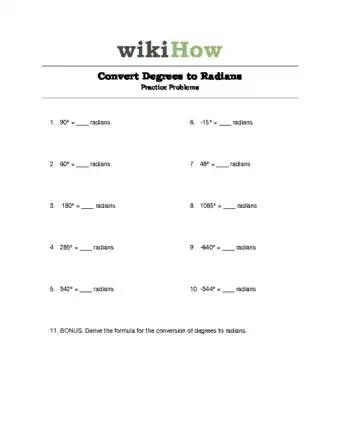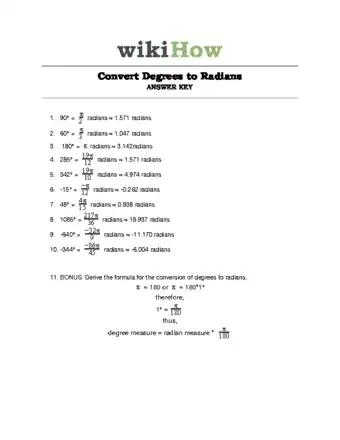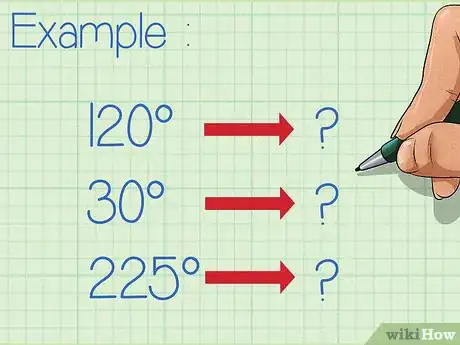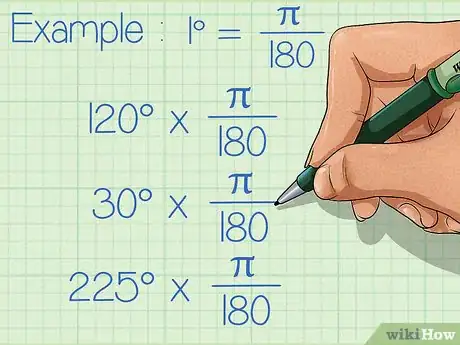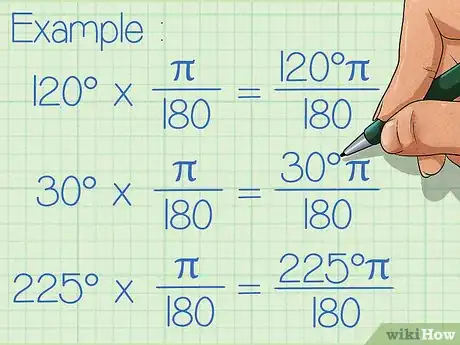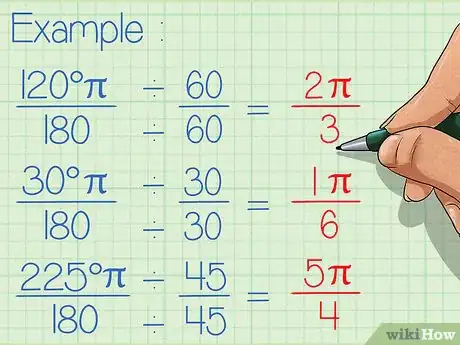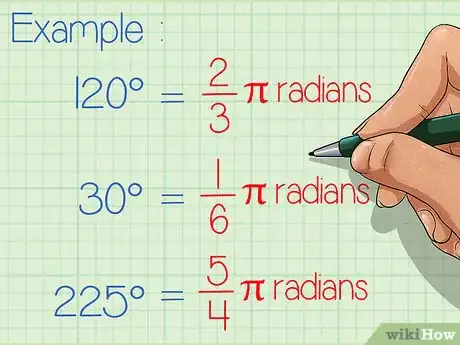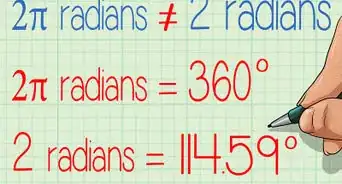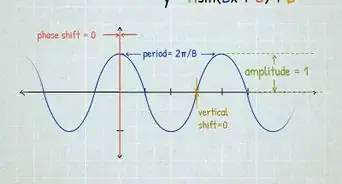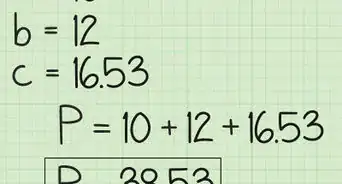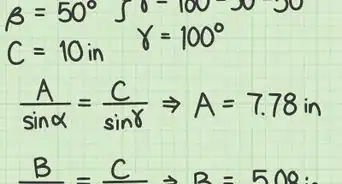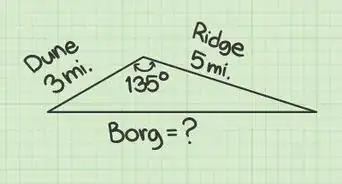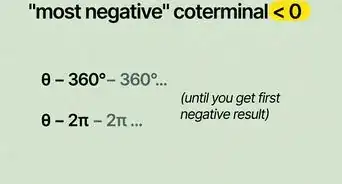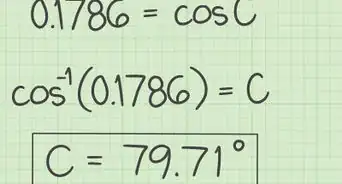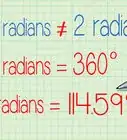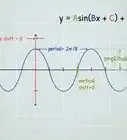wikiHow is a “wiki,” similar to Wikipedia, which means that many of our articles are co-written by multiple authors. To create this article, 16 people, some anonymous, worked to edit and improve it over time.
There are 7 references cited in this article, which can be found at the bottom of the page.
wikiHow marks an article as reader-approved once it receives enough positive feedback. In this case, 85% of readers who voted found the article helpful, earning it our reader-approved status.
This article has been viewed 840,197 times.
Learn more...
Degrees and radians are two units for measuring angles.[1] A circle contains 360 degrees, which is the equivalent of 2π radians, so 360° and 2π radians represent the numerical values for going "once around" a circle.[2] Sound confusing? Don't worry, you can easily convert degrees to radians, or from radians to degrees, in just a few easy steps.
Practice Problems
Steps
-
1Write down the number of degrees you want to convert to radians.[3] Let's work with a few examples so you really get the concept down. Here are the examples you'll be working with:
- Example 1: 120°
- Example 2: 30°
- Example 3: 225°
-
2Multiply the number of degrees by π/180. To understand why you have to do this, you should know that 180 degrees constitute π radians. Therefore, 1 degree is equivalent to (π/180) radians. Since you know this, all you have to do is multiply the number of degrees you're working with by π/180 to convert it to radian terms. You can remove the degree sign since your answer will be in radians anyway. Here's how to set it up:[4]
- Example 1: 120 x π/180
- Example 2: 30 x π/180
- Example 3: 225 x π/180
Advertisement -
3Do the math. Simply carry out the multiplication process, by multiplying the number of degrees by π/180. Think of it like multiplying two fractions: the first fraction has the number of degrees in the numerator and "1" in the denominator, and the second fraction has π in the numerator and 180 in the denominator. Here's how you do the math:
- Example 1: 120 x π/180 = 120π/180
- Example 2: 30 x π/180 = 30π/180
- Example 3: 225 x π/180 = 225π/180
-
4Simplify. Now, you've got to put each fraction in lowest terms to get your final answer. Find the largest number that can evenly divide into the numerator and denominator of each fraction and use it to simplify each fraction. The largest number for the first example is 60; for the second, it's 30, and for the third, it's 45. But you don't have to know that right away; you can just experiment by first trying to divide the numerator and denominator by 5, 2, 3, or whatever works. Here's how you do it:
- Example 1: 120 x π/180 = 120π/180 ÷ 60/60 = 2/3π radians
- Example 2: 30 x π/180 = 30π/180 ÷ 30/30 = π/6 radians
- Example 3: 225 x π/180 = 225π/180 ÷ 45/45 = 5/4π radians
-
5Write down your answer. To be clear, you can write down what your original angle measure became when converted to radians. Then, you're all done! Here's what you do:
- Example 1: 120° = 2/3π radians
- Example 2: 30° = 1/6π radians
- Example 3: 225° = 5/4π radians
Community Q&A
-
QuestionHow do I derive the formula for the conversion of degrees to radians?
 Anan ShahCommunity AnswerSimply: π=180 or π=180*1 degree and therefore, 1degree= π/180, thus, degree measure= radian measure * π/180.
Anan ShahCommunity AnswerSimply: π=180 or π=180*1 degree and therefore, 1degree= π/180, thus, degree measure= radian measure * π/180. -
QuestionWhat is 63 degree 14 min 51 sec in radian form?
 DonaganTop AnswererFirst convert the angle to a decimal. There are 60 seconds in a minute, 60 minutes in a degree, and 3600 seconds (60 x 60) in a degree. 14 minutes 51 seconds equals 891 seconds, which is 891/3600 of a degree or .2475 degree. For simplicity, let's call that ¼ of a degree. Therefore, the angle in question is 63¼ degrees. As shown in the above article, 63¼° multiplied by (π/180) = 1.1 radians.
DonaganTop AnswererFirst convert the angle to a decimal. There are 60 seconds in a minute, 60 minutes in a degree, and 3600 seconds (60 x 60) in a degree. 14 minutes 51 seconds equals 891 seconds, which is 891/3600 of a degree or .2475 degree. For simplicity, let's call that ¼ of a degree. Therefore, the angle in question is 63¼ degrees. As shown in the above article, 63¼° multiplied by (π/180) = 1.1 radians. -
QuestionWhat is 1085 degrees in radian form?
 DonaganTop Answerer1085° = 6.0277 radians. 1080° is equivalent to three complete circles, 1085° is the same angle as 5° and 0.0277 radian.
DonaganTop Answerer1085° = 6.0277 radians. 1080° is equivalent to three complete circles, 1085° is the same angle as 5° and 0.0277 radian.
References
- ↑ https://betterexplained.com/articles/intuitive-guide-to-angles-degrees-and-radians/
- ↑ http://www2.clarku.edu/faculty/djoyce/trig/angle.html
- ↑ https://www.mathsisfun.com/geometry/radians.html
- ↑ https://sciencing.com/to-degree-radian-conversion-7378375.html
- http://www.mathwarehouse.com/trigonometry/radians/convert-degee-to-radians.php
- http://www.purplemath.com/modules/radians.htm
- http://www.mathinary.com/degrees_radians.jsp
About This Article
To convert degrees to radians, take the number of degrees to be converted and multiply it by π/180. You can calculate this by converting both numbers into fractions. For example, to convert 120 degrees you would have 120 x π/180 = 120π/180. Once you’ve gotten your answer, simplify the radians. For more examples of converting degrees to radians, scroll down!
